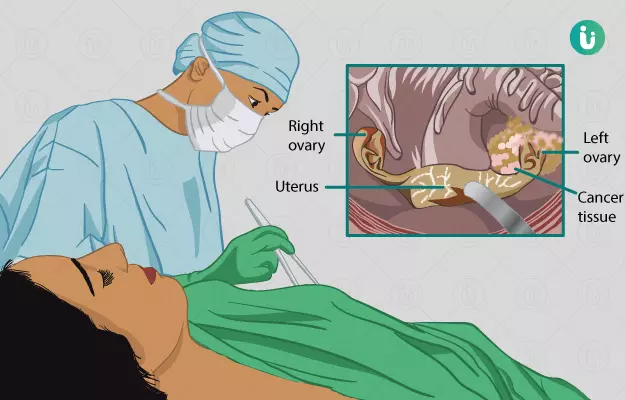It involves complete removal of the cancerous cells and surrounding tissues from the ovaries. The type of surgery needed depends on the spread of cancer in the body. It is usually treated and looked after by a team of gynaecologic oncologist (a cancer doctor), radiation oncologist, and medical oncologist. These doctors specialize in treating cancer. Other specialists may include physicians, nurses, psychologists, sex counsellors, and other health professionals.
There are different operations for various stages and types of ovarian cancer. Therefore, your doctor will carry out tests to detect the stage of cancer to plan the type of operation you will need.
Often, the operation may involve one of the following:
Removal of the womb:
- Total Abdominal Hysterectomy (TAH)
It involves removing both of your ovaries and the womb.
- Bilateral Salpingo-oophorectomy or BSO
In this, the removal of both the ovaries and tubes is done on both sides.
- Omentectomy
This refers to the removal of any infected part near the ovaries or cancer spread to adjacent organs (for example, removal of fatty layer over the end of intestine/bowel).
Fertility Conservation:
In this operation, ovaries and tubes will be removed only partially, and the womb will be left intact. This procedure is done if you are at the initial or starting stage of this cancer. After this procedure, you will most likely be able to get pregnant. However, if further samples detect that cancer has spread, this will mean that you need a second operation.
Debulking Surgery:
This is considered to be the most successful operation in treating ovarian cancer completely. Although, there may be some factors related to the complexity of cancer that may cause it to come back. This is the procedure of choice when cancer has spread to other areas in the hip and lower belly region. The aim of this surgery is to leave behind no visible cancer or tumours larger than 1 cm (known as optimally debulked). This procedure will include the removal of ovaries, tubes, womb, and part of your lower digestive system (for example, large or small intestine).
In severe cases, the large intestines and stool collection area cannot be tied back together after the tumour is removed. Therefore, an opening in the large intestine is made to hang the bag out from the skin; this is used to collect the bowel waste in it. Later on, it is reattached to its former position. Special care must be given to you in this either in the hospital or at home. People undergoing this surgery usually have a better outcome (prognosis) than those with partial surgeries.
Other organs that may need removal within this procedure include the colon (a part of the large intestine), a piece of the small intestine, a part of the gallbladder (a small organ present below the liver, which releases bile for fat digestion) along with the placement of a thin tube called catheter, and the spleen and/or the gallbladder, as well as part of the stomach, liver, and/or pancreas. However, this is done only in a few cases.
Surgery for epithelial cell tumour:
This procedure usually involves ‘staging’ and ‘debulking process’. Staging is a process where the surgeons and specialists categorise the tumour and examine them during surgery prior to their removal. This is important to plan future surgeries and to understand the spread of cancer so that you can be fully treated. If there is fluid accumulation in your lower belly or the space in the belly, it will be removed by your surgeon. The surgeon may "wash" the inside of your belly with salt water (saline) and collect this fluid. He or she may also take tissue samples from different areas inside the belly. All the tissue and fluid samples that are taken during the operation are sent to a lab for testing to look for cancer cells.
Surgery of ovarian germ cells and stromal cells:
The main goal at this stage is the removal of cancer completely. The ovarian germ and stroma cell (cells that produce eggs and keep them protected) cancer is usually present in one of the ovaries and hence, it may be advised to just remove the affected side. Sometimes, as a precaution, once you have your final pregnancy, surgery to remove the remaining ovary, the other fallopian tube, and the uterus may be recommended for both germ cell and stromal ovarian tumours.
Overall, the total cost of ovarian cancer surgery depends on the type and extent of spread of cancer and may range between 3,00,000-3,50,000 INR.












